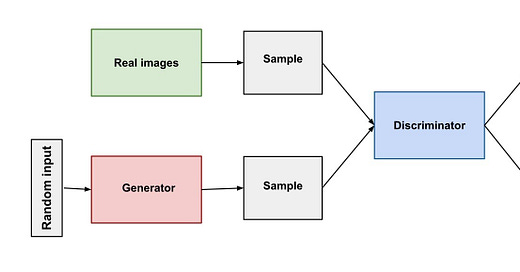For any questions, mail us at vipul@businessanalyticsinstitute.com
Hello!
Welcome to today's edition of Business Analytics Review!
Today’s edition dives into a foundational topic in machine learning: the technical comparison between generative and discriminative models. Whether you’re building AI systems or just curious about how models “think,” understanding these two approaches is key to mastering the field. Let’s break it down with clear examples and practical insights.
What’s the Difference?
At their core, generative and discriminative models tackle the same challenge—classification—but from fundamentally different perspectives.
Generative Models learn the joint distribution (P(X,Y)P(X,Y)) of features and labels. By doing so, they can generate new data points that resemble the training set. For example, a Naïve Bayes classifier models how each feature occurs in each class (assuming conditional independence) and uses Bayes’ theorem to predict the class of new data Other examples include Hidden Markov Models, Gaussian Mixture Models, and deep generative networks like Variational Autoencoders (VAEs) and Generative Adversarial Networks (GANs). These models are often used for tasks like data generation, data augmentation, or unsupervised learning where capturing the underlying distribution is important. Because they make stronger assumptions (e.g. feature independence in Naïve Bayes), generative models tend to have higher bias but lower variance – they can perform well with less training data. However, their focus on modeling the data distribution makes them sensitive to outliers and model assumptions
Discriminative Models, on the other hand, learn a direct mapping from inputs to labels. They focus on modeling the conditional probability (P(Y∣X)P(Y∣X)) or decision boundary between classes. For instance, logistic regression fits a sigmoid function to estimate the probability of each class given the features. Other examples include Support Vector Machines, Neural Networks, Decision Trees, and k-Nearest Neighbors. These models are typically used for supervised classification tasks. They do not attempt to model the data generation process and therefore cannot generate new examples, but they usually achieve better classification accuracy when enough labeled data is available. Discriminative models are generally more robust to outliers and do not require strong distributional assumptions about the features.
Technical Comparison Table
Model Examples: Naïve Bayes vs Logistic Regression
Naïve Bayes (Generative):
Naïve Bayes models the probability of each feature for every class, assuming feature independence. For example, in spam detection, it calculates the likelihood of each word appearing in spam and non-spam emails, then uses Bayes’ theorem to classify new messages. Its strength lies in simplicity and ability to handle missing data, but it may be less accurate when features are not truly independent.
Logistic Regression (Discriminative):
Logistic regression learns the direct relationship between features and class labels by estimating the probability that an input belongs to a particular class. It draws a decision boundary (like a line in 2D space) that best separates classes. It’s widely used for binary classification tasks and generally achieves higher accuracy when the dataset is well-labeled and features are informative.
Industry Insights
Generative models are powering advances in synthetic data generation, creative AI (like image or text synthesis), and robust handling of incomplete datasets.
Discriminative models remain the go-to for high-accuracy classification in business analytics, fraud detection, and customer segmentation, thanks to their efficiency and focus on boundaries.
Recommended Reads
Generative vs Discriminative Models: Differences & Use Cases
A comprehensive breakdown of the mathematical and practical distinctions between these model types.What Are Naïve Bayes Classifiers
Explains how Naïve Bayes works, with clear examples and real-world applications in text classification.Discriminative Model Explained: Key Concepts & Uses
Focuses on discriminative models, especially logistic regression, and their role in modern AI systems.
Trending in AI and Data Science
Let’s catch up on some of the latest happenings in the world of AI and Data Science
Nvidia’s Blackwell Chips Double AI Training Speed
Nvidia’s new Blackwell chips have dramatically reduced the number of chips needed to train massive AI models, outperforming previous generations and setting new industry benchmarks for speed and efficiencyYageo to Retain Shibaura’s AI Tech in Japan
Taiwan’s Yageo plans to keep Shibaura Electronics’ advanced AI sensor technology in Japan if its acquisition succeeds, aligning with Tokyo’s goal to safeguard domestic innovation and technological leadershipUK Delays AI Regulation for Broader Legislation
UK ministers have postponed AI regulation by at least a year, aiming to introduce a more comprehensive bill that addresses rapid advancements and growing risks in artificial intelligence
Trending AI Tool: Blueprints
Blueprints AI refers to pre-designed templates or frameworks that simplify the development of artificial intelligence solutions. These blueprints offer structured workflows for data processing, model training, and deployment, allowing developers to build AI systems more efficiently. They reduce complexity, save time, and enable rapid prototyping without requiring deep technical expertise
Learn more
For any questions, mail us at vipul@businessanalyticsinstitute.com









This is a great overview of generative versus discriminative models! It's so important to understand these fundamental differences, especially as AI continues to evolve. The technical comparison table is super helpful - a great way to quickly digest the key distinctions.
I've been thinking a lot about how these models play a role in data privacy. Generative models, with their ability to create synthetic data, offer some really interesting possibilities for privacy-preserving AI. It's a space with huge potential, but also requires careful consideration to ensure the synthetic data is truly representative and doesn't inadvertently leak sensitive information.
Thanks for sharing this insightful piece!